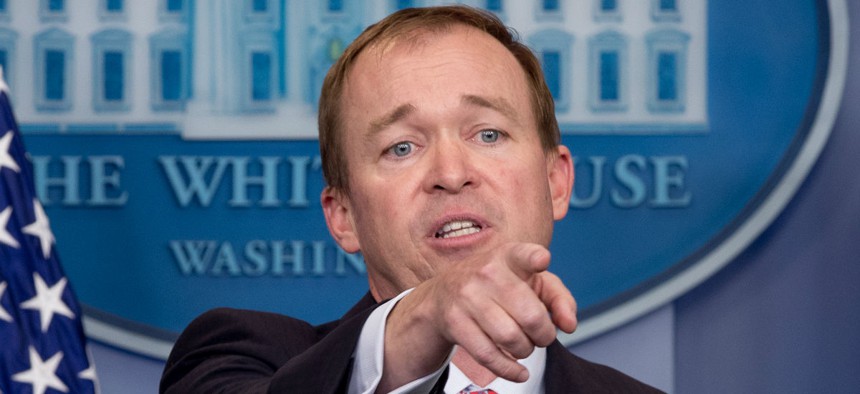How Unions Hope to Protect Their Members Amid Upcoming Agency Reforms
Employee advocates urge management to consult with them early on in the reorganization process, but there is no legal obligation to do so.
Federal employee union representatives are hopeful that agency leaders will consult with them early in the process of developing workforce reduction plans mandated by the Trump administration, but acknowledged in interviews with Government Executive that they have no way of forcing agencies to do so because it is not a legal requirement. Indeed, unions’ strongest leverage for protecting their members during the executive branch reorganization effort may result from lobbying Congress.
Unions have some reason to be optimistic that agency managers will consult with them as they draw up their downsizing plans, required by Office of Management and Budget Director Mick Mulvaney in guidance last month. OMB Senior Adviser Linda Springer told Government Executive in a separate April interview that agencies’ political leadership will rely on career staff as they put together their strategies.
“We are operating under the notion that the career civil servants know better than almost anyone, because they live with this day in and day out, and they experience the challenges of doing their work,” Springer said. “So from the standpoint of how things can run better, or whether or not what they’re doing is used or has value, I think they are right on the front lines.”
Jacque Simon, policy director for the American Federation of Government Employees, which represents around 700,000 federal workers, also said the first step in any discussion of streamlining an agency must be to talk with the rank-and-file.
“There are some good ideas in the guidance, and ideally [leadership] would sit down and talk to front-line workers about their ideas for how to save money, where resources should go and what kinds of needs they’ve been made aware of through the course of their work,” Simon said. “And you’d have some constructive conversations about how best to accommodate the budget parameters agencies are faced with. That’s how it ought to work.”
OMB’s guidance requires agencies to submit a high-level version of their reform plans by June 30, including a report on progress on near-term workforce reduction and a proposal “to maximize employee performance.” In September, after discussions with OMB’s Resource Management Offices, agencies will submit their final reform plans and long-term strategies for workforce cuts as part of their fiscal 2019 budget requests.
Simon expressed concern that agencies’ approaches to crafting workforce reduction plans will differ depending on the Trump administration’s opinion of their missions and leadership. Administration officials are not required to come to the bargaining table with unions until they plan to implement changes that would alter union members’ terms of employment, which can include issues like relocation; changes to the workday or workspace; and reductions in force, or layoffs.
“There are many, many mixed messages in that [OMB guidance] document, and it’s up to agency heads to see what they will take from it—will they take the smart approach, or a dumb approach—and it will vary,” she said. “With some agencies, they just want to detonate the agency—like [the Environmental Protection Agency]—but with others, where the agency head wants to see the mission carried out, like [Homeland Security, Defense and Veterans Affairs], where they actually care about the mission of the agency,” they will be more strategic.
AFGE plans to try to sell management on an inclusive reorganization process, although Simon acknowledged there are few concrete steps the union can take to ensure that happens.
“I think the leverage is: Do you want the buy-in and the cooperation of employees?” she said. “Do you want an agency that functions and carries out its mission? Or do you want a dysfunctional agency starved of resources in an important area and too many resources in an unimportant area? … We will certainly ask management to sit down with us and keep us informed, we want a full briefing on anything the agency intends to do, and we want to see plans in advance and would like to be given an opportunity for feedback.”
The National Treasury Employees Union also stressed the importance of engaging the rank-and-file early on in restructuring efforts. “No effective reorganization of government is possible without the ideas and recommendations of front line employees who have dedicated their careers to serving the public,” said Tony Reardon, president of NTEU. “Only with their input can meaningful reforms of the executive branch be accomplished.”
NTEU is also planning to use Congress as a pressure point. “Congress has the final word on how government is structured and funded,” Reardon said. “And we believe Congress will ultimately recognize the harm that these deep cuts would do to American taxpayers and the services they rely on, and that layoffs can be avoided.”
If reductions in force are ordered, then NTEU plans to push for ways to help those who lose their jobs find new federal positions or secure financial compensation or early retirement.
“NTEU would work to safeguard employees,” he said. “In the case of reductions in force, NTEU would work to ensure priority placements, early outs or buyouts and use other mitigation tools as provided under current law to protect employees.”




